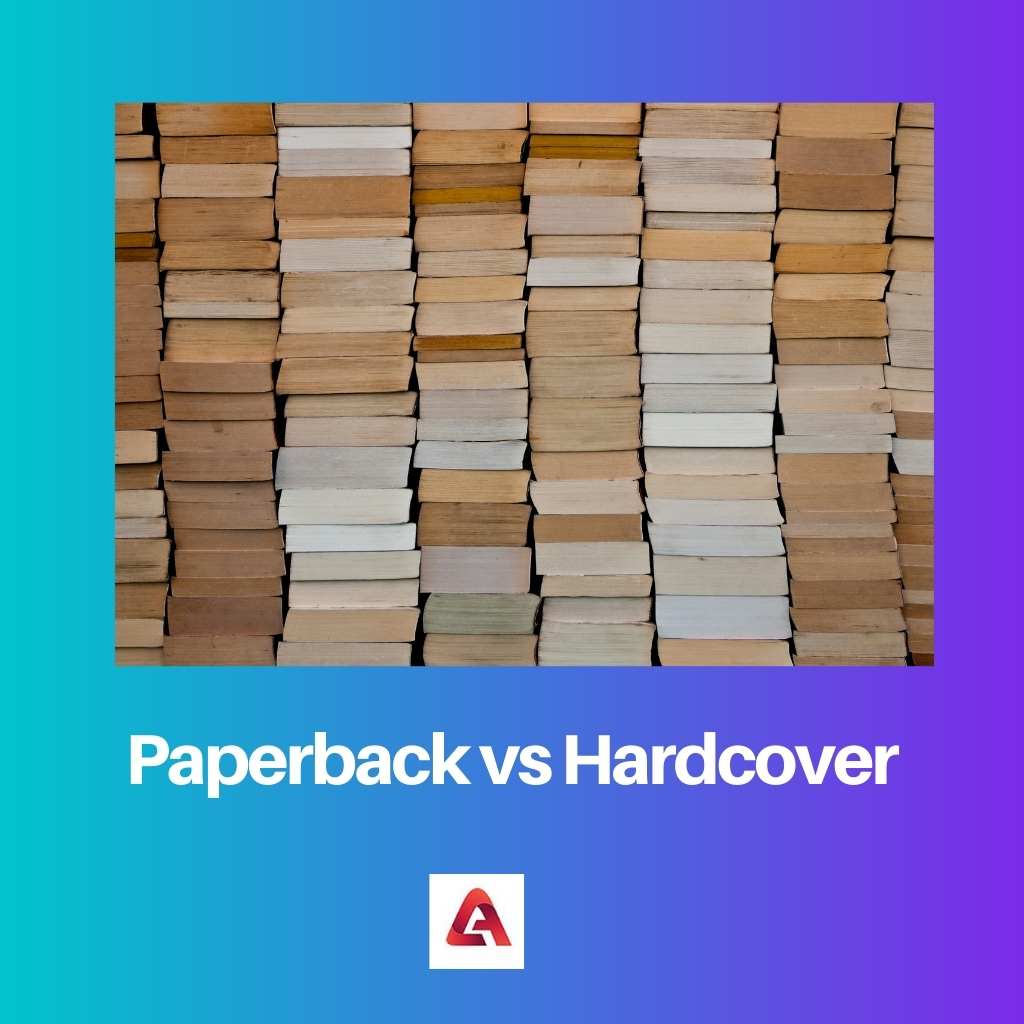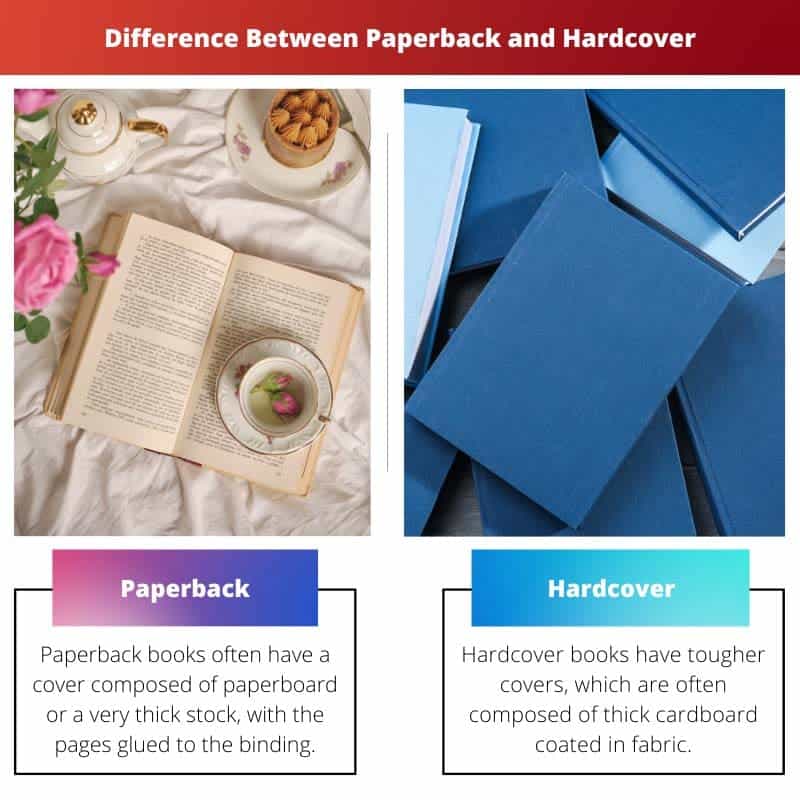Paperback, hardcover books, and bookbinding technologies are two types of books. A paperback is sometimes known as a softback or softcover.
Meanwhile, a hardcover book is also known as a hardback or hardbound book. Trade paperbacks and mass-market paperbacks are two types of paperbacks.
Key Takeaways
- Paperbacks feature flexible, laminated paper covers, while hardcovers have rigid, durable covers made from cardboard or cloth.
- Paperbacks are more affordable and lightweight than hardcovers, making them popular for casual readers and travelers.
- Hardcovers offer better protection and durability for books, making them preferable for collectors and libraries.
Paperback vs Hardcover
A paperback is a book cover made with paper. Its durability is less. Almost all new books are first published in paperback to identify the reaction of the public. If the book sells well, then Hardcovers can be published. A hardcover is a book cover made with hard material. It has high durability. Bestsellers books are almost hardcover books.

Paperback (also known as softcover or perfect-bound) books have a cover composed of paperboard or a very thick stock, with the pages glued to the binding.
Regarding paperback book printing, we refer to trade paperbacks, which are the 6×9 or 5.5×8.5–inch books you find in shops.
Hardcover (also known as casebound or hardbound) books have tougher covers, which are composed of thick cardboard coated in fabric.
The pages can be bonded or sewed into the spine at this point, making the spine more flexible and allowing the book to rest flat when opened. The book title and author’s name are frequently imprinted onto the cloth binding.
Comparison Table
| Parameters of Comparison | Paperback | Hardcover |
|---|---|---|
| Structure | Books with a cover or paperboard cover. | Books with a cardboard cover along with a dust jacket |
| Durability | Less durable | More durable |
| Quality of Paper | Normal papers | Acid-free paper; not easy to wear and tear. |
| Type of Books | Books with less value, and can be read for a short time. | Reference guides, library books, bestsellers, etc. |
| Size | Smaller | Larger |
| Convenience | More convenient | Less convenient |
| Appeal | Less | More |
| Availability | Higher | Lower |
What is Paperback?
When it comes to paperbacks, the cover is comprised of thin paper that is glued to the leaves. Paperbacks are intended for shorter readings, such as those found in salons, on planes, and in airport lounges.
Paperback versions are seen for books that are not particularly valuable or for books that already have hardcover copies on the market.
Non-commercial works are published in paperback to attain at least a break-even point, as profit is the last thing on the publisher’s concern.
It is done on purpose since it is believed that fans of the author will buy the hardback edition. Paperback editions of all new writers’ works are always available, and this is because the publishers are unsure of the public’s reaction to the new book and do not want to incur losses if the book does not sell.
This covering is less in weight but prone to folding, bending, and creases with usage and over time. Rather than stitches or staples, glue is frequently used to hold their pages together.
These books are smaller in size, lighter in weight, and even more affordable in price. These volumes, however, are extremely fragile and easily destroyed, necessitating cautious handling and care.
There is a less expensive variant of paperback novels called mass-market paperback.

What is Hardcover?
A hardcover book, as the name suggests, is bound with a protective cover. It normally comes with a dust jacket on top. Books without this jacket cover are becoming more common these days.
The goal of publishing a book in hardcover is to increase durability and protection.
Hardcover versions of popular books are easier to find as they become collector’s goods. For instance, the Harry Potter series of novels.
They exist in hardback, and the publishers initially published them in hardcover because they knew people would buy books regardless of price since it was Harry Potter.
Hardcover versions are popular in libraries and institutions due to their durability and lifespan since they are not readily damaged. The interior sheets of hardcover versions are also chosen with care.
Because the paper is acid-free, it has a pH of 7, which is considered neutral. This paper is more robust and resistant to wear and tear.
Hardcover books are distinguished by their thick and solid cover. This cover protects the pages and keeps the book sturdy and useable for a long time.
A dust jacket (also known as a slip-on jacket, book jacket, dustwrapper, or dust cover) protects hardcover volumes from dust and other wear and tear. Some books are even made more durable by coating them with leather or calfskin.
Another distinguishing aspect of a hardcover book is the presence of a protective coating on the spine.
Because of this, many collectors’ versions are hardcovers. Along with collector versions, reference books are also available in hardcover. This method ensures that the initial purchases are in hardcover, which is more profitable for publishers.

Main Differences Between Paperback and Hardcover
- A paperback book has a paperboard cover, whereas a hardcover book has a cardboard cover and a dust jacket that is provided for extra protection.
- Paperback books are less durable than hardcover.
- Paperback books have normal quality paper, whereas hardcover book tends to have acid-free paper, and their papers are not easy to tear and wear.
- Paperback versions of novels come with lesser value or mass-produced books, while hardcover versions can be seen as library books, bestsellers, etc.
- A paperback book is smaller in size in comparison to a hardcover book.
- Paperbacks are more convenient as they are flexible and easier to carry, whereas hardcover books are less convenient.
- The physical appeal and attractiveness of paperbacks tend to be less than hardcovers.
- Paperbacks are available in a higher number, whereas a hardcover version of a book is available in lesser quantity.

- https://www.tandfonline.com/doi/abs/10.1080/08997764.2011.549428
- https://books.google.com/books?hl=en&lr=&id=tc7_AwAAQBAJ&oi=fnd&pg=PP1&dq=paperback+and+hardcover&ots=3nYbZap_44&sig=P4cckZaiyT-gL3TM31__PQhQ1wc
